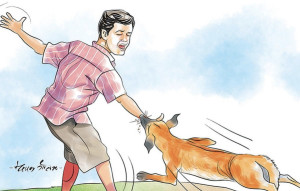Columns
Minimising the use of antibiotics
Antibiotic-resistant bacteria could cause a 2.5 to 7.5 percent decline in livestock productivity by 2050.
Surendra Karki & Ashmita Gautam
The unintentional discovery of Penicillin in 1928 AD by Scottish physician Alexander Fleming marked the beginning of the era of antibiotics. With the development of this drug, the mortality of people and livestock from common ailments decreased miraculously. In the following few decades, several other effective antibiotics were discovered, which helped to revolutionise modern medical practices. These “magic bullets” helped people survive several lethal infections. Today, however, several antibiotics and other antimicrobials sold on the market are losing their efficacy and are no longer equally effective against pathogens which they used to kill previously. This phenomenon is commonly known as antimicrobial resistance (AMR). Rising concerns are legitimate as no new class of efficient antibiotics has entered the market in the last 30 years.
AMR occurs when bacteria, viruses, fungi, and parasites become powerful and do not respond to antimicrobials which used to kill them previously. Drug resistance makes illnesses difficult or impossible to treat and renders antibiotics and other antimicrobial medications ineffective. This might cause people and livestock to die from simple infections in the future. The problem of AMR was referred to as a slow-moving tsunami by Margaret Chan, the former Director General of the World Health Organization (WHO), due to its silent spread.
Although the microbes changing their shape is entirely a natural phenomenon, human-made factors such as the rampant use of antibiotics in humans and livestock, over and under-dosing of antibiotics, use of antibiotics for viral infections (such as the common cold), poor sanitation practices, and poor waste management in medical and veterinary healthcare facilities, hospitals and livestock farms have created enabling environment for pathogens, including bacteria to change their forms much more quickly than expected and turning them into “superbugs”.
The absence of reliable laboratory data about antibiotic-resistant bacteria in hospitals is making it challenging for prescribers to administer the right antibiotics. Like in humans, antibiotics are needed to treat infections in animals. However, they are irrationally used on several occasions, even when a veterinarian does not prescribe them. The administration of low doses of feed-based antibiotics, even in healthy animals, raises the likelihood of bacterial drug resistance. Such resistant bacteria enter the environment through animal and human excreta, due to which the environment can serve as a mixing vessel. The Department of Livestock Services in Nepal has banned antibiotics in feed for the past few years. However, an effective monitoring system is yet to be created to understand its implementation status.
WHO estimates that about 700,000 people die yearly from antibiotic-resistant bacteria. If effective control measures are not implemented, by 2050, this figure is estimated to reach 10 million deaths per year. This will result in huge economic losses, estimated to be around $100 trillion.
The livestock sector will also be affected by the burden of AMR apart from the public health sector. A study conducted by the World Bank has estimated that antibiotic-resistant bacteria might cause a 2.5 to 7.5 percent decline in the productivity of the livestock sector by 2050. As a significant proportion of the population in developing countries depends on animal husbandry for livelihood, this will have a huge impact on efforts to fight poverty. As such, globally, 28 million more people will be pushed below the poverty line by the year 2050 if the problem of AMR continues. Therefore, no nation can dismiss the problem of AMR.
Owing to the gravity of the situation, in a special political declaration issued in September 2016, the United Nations General Assembly urged all nations to actively address the issue of AMR and put in place practical measures to curb it. WHO, Food and Agriculture Organization of the United Nations (FAO), the World Organization for Animal Health (WOAH) and the United Nations Environment Program (UNEP) have formulated a global action plan to curb the problem of AMR. Since 2015, these organisations have started the annual celebration of World Antimicrobial Awareness Week (WAAW) in the third week of November. The purpose of WAAW is to raise awareness on AMR and to promote best practices among the general public, healthcare professionals, farmers and policymakers in order to prevent the emergence and spread of illnesses that are resistant to antibiotics. This year, WAAW is celebrated from 18-24 November across the world with a theme of “Preventing Antimicrobial Resistance Together”. Since the problem of AMR is also affecting Nepal, they have drafted a national action plan for AMR control and containment in line with the global action plan with multisectoral involvement. The plan is awaiting final approval.
AMR, thus, is a multifaceted problem. In order to efficiently curb the problem of AMR, all stakeholders involved in the food, environment, animal, and human health sectors should work together with equal engagement and commitment. Building the required regulations, raising awareness among prescribers and the general public, implementing strict biosecurity measures and good husbandry practises in livestock farms, and establishing integrated AMR surveillance systems, laboratory-based prescriptions, laboratory infrastructure, and human resources have become more important than ever for the proper use of antibiotics. Animal and human health, environmental and food sectors need to join hands together and follow one health approach to minimise the impact of the superbugs.




 10.12°C Kathmandu
10.12°C Kathmandu
















